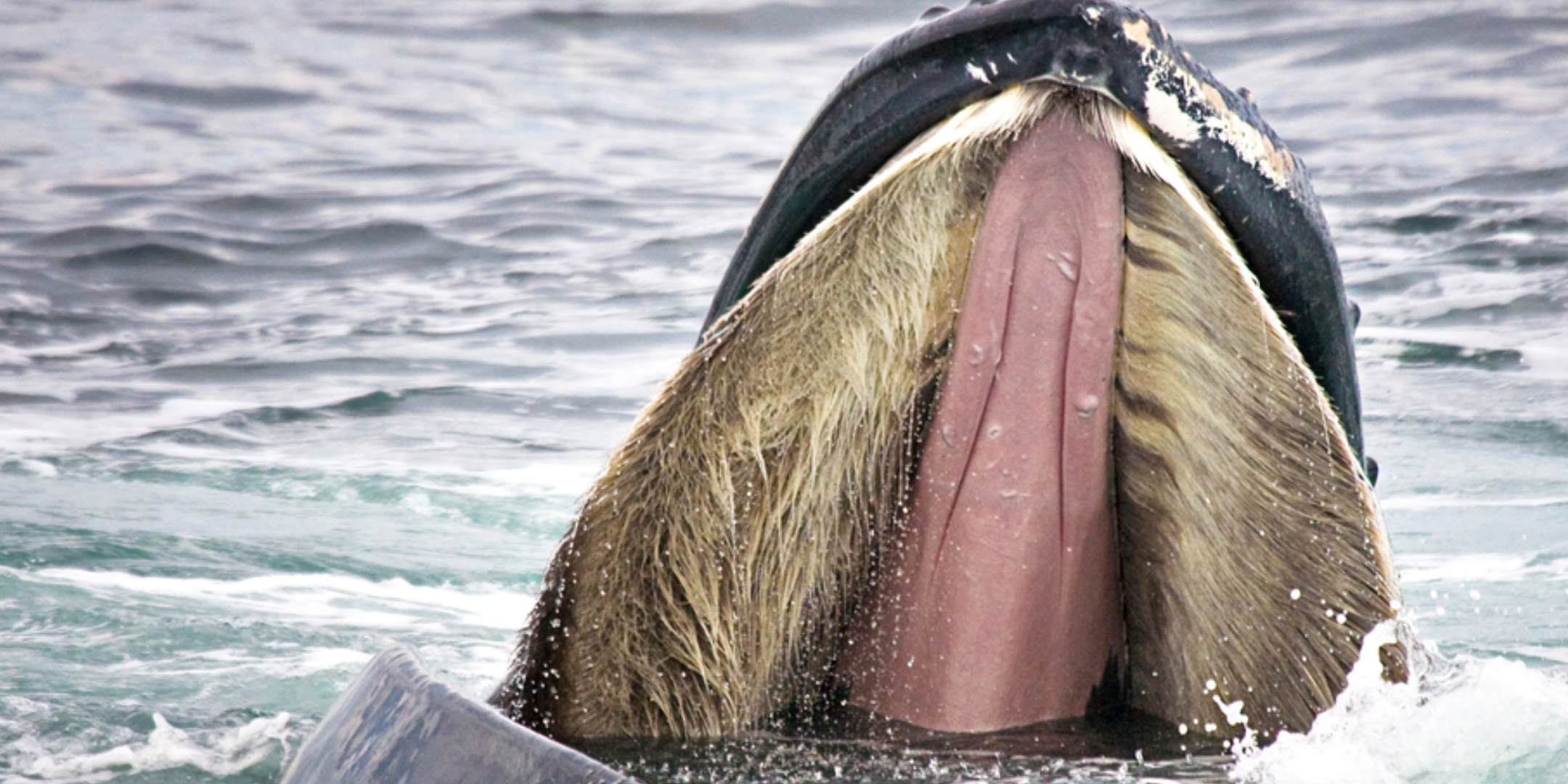
Mysticeti and Odontoceti
Around the time Mysticeti and Odontoceti first emerged, 34 million years ago, Earth’s climate was changing. South America had finally split from Antarctica, and this led to major shifts in ocean currents and to global cooling. Extinctions soared during this period, but a vast southern ocean of deep, salty, nutrient-rich water also fuelled an explosion in the abundance and diversity of diatoms. These tiny marine plants are eaten by small marine animals (including krill), which in turn are eaten by fish and squid, and so on up the food chain.
Wherever you have more food, the feeders will follow. Enter baleen whales, or Mysticeti, a sub-order that evolved to capitalise on this vast marine resource by cutting out the ‘middle man’ in the food chain. Their success demonstrates the important evolutionary role of energy transfer from one level of the food chain to another.
The skull of the earliest known baleen whale, Llanocetus denticrenatus, looked more like a Dorudon ‘s than of a modern baleen whale’s. But Llanocetus, which lived from about 34 to 38 million years ago, had very strange teeth. Each tooth had many round lobes separated by deep grooves, a bit like a palm leaf but with rounded blades. When Llanocetus closed its mouth and forced water out between these teeth, they would have worked like a sieve to trap plankton. Today, crabeater seals (which actually don’t eat crabs) use a similar strategy to eat krill.
Llanocetus teeth provide evidence that Mysticeti adopted a filter-feeding lifestyle before evolving baleen. After Llanocetus came whales thought to have both teeth and baleen (although baleen rarely fossilises, certain mouth features signal its presence), and later still came whales with the specialisations seen in today’s 15 species of bulk filter-feeding baleen whales.
Llanocetus skulls also have openings and spaces which indicate they had rete mirabile, Latin for ‘wonderful net’. This is a type of tissue rich in arteries and veins, which helps protect diving whales from the negative effects of high pressure at great ocean depths. This would have helped Llanocetus plunge to depths that could kill or injure many animals.
The wide-open mouth of a feeding humpback whale—a mysticete, or baleen whale—clearly shows its thick fringes of baleen. IMAGE: JOHN TUNNEY/SHUTTERSTOCK
Baleen whales also evolved heads and jaws that are huge, relative to their body size, to hold their long baleen plates. To open to the greatest possible extent, their lower jaws can almost separate. ‘It would be equivalent to a human’s lower jaw splitting apart and opening so that the two halves of your chin are outside where your ears are,’ says palaeontologist Erich Fitzgerald, Senior Curator at Museum Victoria. ‘These are really extraordinarily different mammals.’
The blue whale, Balaenoptera musculus, is the epitome of efficient energy transfer. ‘No other animal can feed on millions of krill in the space of 24 hours,’ says Fitzgerald. The largest known animals in the history of life on Earth, blue whales can weigh as much as 180 tonnes; their tongues alone weigh as much as an elephant, the largest land animal today.
A blue whale eats about 3.6 tonnes of krill each day. Lunging or swimming into dense groups of these tiny sea animals, a blue whale gulps in enormous mouthfuls of water, extending the volume of its mouth up to six times by expanding the pleated skin on its throat and belly. Then it forces the water out by pressing its tongue forward, trapping krill and other small animals against 320 pairs of black baleen plates hanging from its upper jaw. These flexible plates of dense bristle are made of keratin, the same material as human fingernails.
These extreme specialisations allow blue whales to capitalise on an extraordinary resource. ‘They started down an evolutionary back alley, which then opened up into the superhighway that is bulk filter feeding,’ says Fitzgerald. ‘They “own” that ecological niche; but it puts them at relatively greater risk of extinction in the long term.’ Extreme specialisation has a negative flip side – less evolutionary potential to respond to major disturbances in the environment. ‘If that resource disappears, or becomes much more diffuse, very large baleen whales, at least, may have a difficult time.’ And like other huge animals, these whales lead ‘slow lives’, reproducing slowly and adding new individuals to their population at a very low rate.
Perhaps these traits could help explain why blue whales, which were killed in their hundreds of thousands by whalers last century and driven to near extinction, have recovered only slowly since a 1966 ban on their hunting. Today they still number as few as 10,000 animals.
Unlike the nice picture of gradually accumulated specialisations we see over mysticete evolution, there is little in the fossil record to link the 76 living species of odontocetes to any ancestors. ‘As soon as the odontocetes appear in the fossil record, they’re odontocetes,’ says Fitzgerald, ‘They have the entire set of tools in the odontocete toolkit.’
An orca, showing the peg-like teeth typical of odontocetes. IMAGE: CAMPCRAZY PHOTOGRAPHY/SHUTTERSTOCK
Though named for their numerous peg-like teeth, odontocetes’ most important new features are adaptations for echolocation, also called biosonar. These whales use reflected sound to locate prey at murky depths, where vision is of little help. Far more sophisticated than any sonar we humans have ever developed, whales’ biosonar allows them to ‘paint pictures’ with sound so detailed, they can tell an object’s size, shape, distance, speed and even surface texture.
To produce these sounds, whales developed special skull traits, including a complex set of nasal sacs and passages. One key feature is the ‘melon’, a fatty lump of tissue in their heads, believed to act as a sort of acoustic lens, concentrating and directing sound waves.
A beaked whale, a member of the Odontoceti, or toothed whales. Dolphins, killer whales and sperm whales are also odontocetes. IMAGE: NOAA Photo Library/Wikimedia Commons
